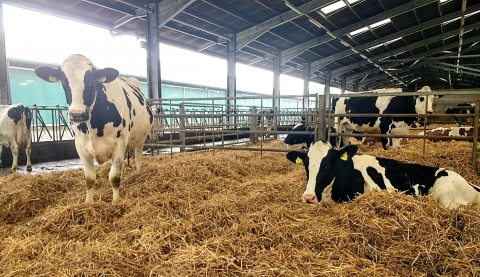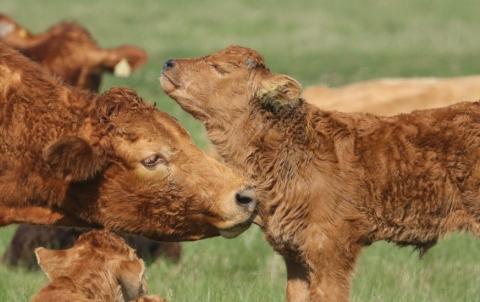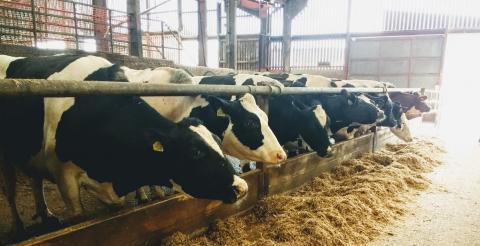14 July 2021
Dr Cate Williams: IBERS, Aberystwyth University.
- Night-time calving can be a significant source of stress for the farmer and can be dangerous if cows encounter difficulties that require assistance.
- In a quest to reduce night-time calving, some research has had success with feeding at night (approx. 16:00-20:00) and restricting access the following morning.
- Some studies report up to 91% of animals calve during the day using this method, whilst others have observed no effect at all.
- There are many behavioural and physiological indicators for calving, although feed withdrawal is not a reliable indicator, a reduction in feed intake can reliably predict calving 2 -24 hours prior.
- Cameras and sensors may be of great help in predicting calving, with tail-mounted accelerometers being extremely reliable up to 3 hours before birth.
Calving can be an extremely stressful time for the farmer – long hours, sleepless nights, bad weather and challenging calving issues are a few things that spring to mind. Using additional labour and contractors can be extremely costly and can significantly impact the farm’s bottom line. Night-time calving also becomes an issue when cows need help – the most common difficulty being dystocia where the calf is oversized, becomes stuck and risks suffocation. In the UK dairy herd, around 16% of calvings require assistance (due to a variety of potential problems) which can often be provided by a skilled and experienced farmer, on-site. Of course, this is complicated by the fact that farmers need to sleep! In an attempt to minimise undetected calving difficulties and allow farmers a little more rest, research has looked at methods of reducing night-time calving. Anecdotally it is widely assumed that prey animals prefer to give birth under the cover of darkness to reduce the risk of predation on both mother and offspring. However, there is no evidence to support this, with studies suggesting that most animals, including cattle, show an even distribution of births throughout the day and night. Instead, one of the most significant factors affecting the timing of birth is feeding schedule which may be manipulated to reduce night-time calving
Can we reduce the occurrence of night-time calving?
Possibly the best-researched method for influencing calving time is varying feeding times, anecdotal evidence supports the theory that feeding in the evening will cause cows to calve in the day, but published experiments are somewhat lacking. The same is true for studies looking at calving patterns, as it is widely assumed that animals, particularly prey species, give birth at night, under the cover of darkness. It is hypothesised that this may be to reduce the risk of predation on mother and offspring, or in domestic and captive animals this is the time with the least human activity which may be perceived as a threat. However, we have yet to document any consistent temporal pattern for parturition in any ruminant species and most studies suggest that births are more or less evenly distributed throughout the day and night.
The most extensively researched and implemented strategy to reduce night-time calving is to delay feeding, usually between 18:00 and 20:00 and then restrict access 12 hours later (06:00 – 08:00) the following morning. The reason behind this mechanism is unknown, but hypotheses include the effect of rumen contractions on uterine contractions and hormonal changes induced by feeding. A study from the 80s investigated this effect in 129 Holstein cows and heifers. A TMR was offered free choice for the control group and the experimental group’s access was blocked between the hours of 08:00 and 20:00. Results showed that 62.5% of control animals and 67.6% of night-fed animals calved during the day (06:00 to 18:00). If a farmer’s average day spans 05:00 to 21:00, 82.8% of control animals and 84.6% of night-fed animals calved during the day. Overall, this study found no significant effect of feeding on time of calving or for any health-related parameters that were assessed, however, results did show a change in the cow’s behaviour and adaptation of the circadian rhythm to feeding time.
However, results testing this hypothesis are mixed. In one paper, beef cattle were split into two groups, one of which was fed in the morning (between 06:00 and 08:00) and the other in the evening (16:00-18:00). Those fed in the morning calved throughout the day and night, whilst feeding in the evening resulted in 85% of the herd calving during the day. The study also found that cows tend to calve at a similar time of day year on year, usually within a 4-hour window, in addition, a heifer’s birthing time seemed to be similar to their dam’s. On the other hand, a similar experiment using dairy cows did not see such a stark effect. In one group, silage was fed in the evening (17:00 - 20:00) after a period of restricted access, while in the control group ad-lib access was provided. Restricting access to silage resulted in slightly fewer calvings at night compared to those with ad-lib access (18 and 22%, respectively). But cows with restricted access also had a higher percentage of difficult calvings (11 vs 7%) and stillbirths (7 vs 5%) compared to cows in the control group. These studies suggest that night-time feeding may result in more daytime births, but it remains to be clarified how significant this effect is.
Anecdotal evidence that has not been peer-reviewed and published includes research by American rancher, Gus Konefal who reported that 80% of his cows calved between 07:00 and 19:00 when fed later in the day. Established in 1980, his method includes a twice a day feeding, the first between 11:00 and 12:00 and the second between 21:30-22:00. Iowa State University implemented this strategy, altered to one feed per day at 16:00. This regime is claimed to result in 82% of cows calving in the daytime (between 06:00 and 20:00). 91% calved when ‘daytime’ was extended to 05:00 - 23:00. It is reported that researchers at the United States Department of Agriculture conducted a three-year study evaluating the effect of feeding time on calving, but the numbers were not as dramatic as in the aforementioned studies. There was a consistent 10-20% decrease in the number of cows calving between 22:00 and 06:00 in late-fed cows compared to those fed earlier. Whilst this evidence appears online, it has not been published in peer-reviewed format, so should be treated with caution.
Feeding methods for reducing the frequency of night-time calving would benefit from further research using large sample sizes, both dairy and beef breeds and different diets to give more solid evidence on its efficacy. On-farm trials would also be useful to ensure this effect is carried over and to assess the extent of time (stress) and cost savings for the farmer.
General indicators of calving
Before and during calving cows will withdraw from feed and water, possibly as a pain response and/or as the calf moves into position and compresses the rumen. Due to this reduced intake, many cows will begin lactation in a state of negative energy balance (NEB) – where they are not taking in as much energy as they are using. In a normal situation, the cow will correct this herself and resume eating and drinking again sometime after calving, although in some cases NEB can lead to utilisation of body fat reserves resulting in ketosis or milk fever. Generally speaking, withdrawal from feed can be used as an indicator of calving in conjunction with other behaviours (e.g. pawing, shifting weight, getting up and down or tail lifting and swishing) and physiological signs (bagging up, relaxation of the tail and pelvic ligaments and swelling of the vulva).
Studies suggest that feeding and drinking duration begins to decrease around 2 hours before parturition and that interest in feed returns around 6-12 h after calving. A reduction in feeding duration by 52% has been observed 2 hours before calving and a 91% reduction in drinking during the same period. Feeding duration showed a steady, linear increase over the 24 hours post-calving. However, whilst there was a marked reduction in feeding duration, cows did not withdraw from feed altogether, suggesting that feed withdrawal in isolation is not a reliable indicator of calving, whilst feeding duration is more accurate. Some have found that feeding time, rumination time and feed intake can begin to decline as early as 3 weeks before calving, whilst others report that the more significant and noticeable reductions in feeding duration (66 mins on average) occur 24 h before calving. Whilst studies support the assertion that a reduction in feeding time may be used as an indicator for calving, they also emphasise that there is significant variation between individuals and that this should be paired with other behaviours for reliability. The reasons behind incomplete and inconsistent feed withdrawal prior to calving are unclear, but rupture of the amniotic sac may make space in the cow’s abdominal cavity, allowing the rumen to expand and prompting the cow to eat.
A good working relationship and knowing individuals in the herd is invaluable in identifying abnormal behaviour which may indicate calving or illness. Another option, of course, is the use of new technologies – mostly sensors and cameras – to automatically detect calving. The tail-mounted accelerometer, Moocall has been validated using independent tests which found the device reported no false negatives and was able to accurately predict calving at 24 h, with only a small reduction in specificity and sensitivity at 3 h. Other methods, for example, monitoring of intra-vaginal temperature can also detect calving but is subject to quite substantial variation throughout the day meaning that it must be monitored continuously to avoid false alarms. Whilst the initial investment needed for such devices might be large, the offset in labour savings and the ability to intervene early in difficult births will likely pay dividends in the long term.
Summary
The common assumption that prey animals prefer to give birth at night may not be correct, instead, the scientific literature suggests that in ruminants there is an even distribution of births through the day and night. Regardless, night-time calving can present a source of great stress to the farmer and a risk to heifers and cows. Possibly the best-researched method to reduce night-time calving is feeding cows in the evening, usually around 18:00-20:00 and then 12 hours later, restricting access to food. Anecdotal use of this strategy has produced dramatic results, with reports of 80-91% of herds calving during the day when fed later. However, it is important to note that this data is not peer-reviewed or published, and the scientific literature presents a rather different story. Studies have found a less dramatic and varied trend in response to night-time feeding with some reporting 85% of the herd calved through the day whilst others find no effect. Withdrawal from feed is also used as an indicator for calving in conjunction with other behavioural and physical cues. The literature supports this observation, agreeing that both feeding duration and DMI reduce in the time before calving, however, complete withdrawal is rarely observed, which serves to complicate matters. There is also dispute over the timeline for reduced DMI, some report that feeding decreases more than 3 weeks before birth, whilst others suggest that changes occur in the final 2 hours before calving. As such, knowing the herd and their typical behaviours is important, as well as using a wide variety of behavioural and physiological indicators to predict calving. Calving monitors and cameras may assist in the detection of calving, easing pressure on the farmer and making the process more reliable, a popular example of this is the tail-mounted device, Moocall.



